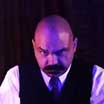
Asexuality and Satanism
Reverend Byrd
Anton LaVey didn’t invent the word “asexual,” nor was the The Satanic Bible the first book to describe asexuality. However, LaVey was likely the first person to explain asexuality in a positive way; in a widely published book available to a large general audience; and in terms that we would recognize as a legitimate sexual identity today. Given the lack of visibility and understanding of asexuality even in 2019, I find its use in The Satanic Bible to be phenomenally progressive for 1969 — albeit unsurprising considering the source. As you read bear in mind this is still an ongoing research project, and while what I present is factual to the best of my knowledge it is also undoubtedly incomplete as there is a copious amount of obscure and obsolete material that would take great cost and time to sort through. Also, I am not asexual and I am not attempting to speak for asexuals. I’m merely interested in the origin of the word in relationship to its use in The Satanic Bible, and how The Satanic Bible was likely the first source to embrace the word as a positive thing that we would recognize by modern standards.
The Online Etymology Dictionary sites asexuality as, “1829, as a term in biology, ‘having no sex or sexual system,’ a hybrid from a- ‘not’ + sexual. In general contexts, ‘wanting [i.e. lacking] sexuality, being of or referring to neither sex,’ attested from 1896." Presumably “attested from 1896” is in regard to the work of Magnus Hirschfeld with his “Sappho und Sokrates,” published that year. As far as I can tell the word “asexual” is not actually used, but rather “Anesthesia Sexualis” is used to describe individuals “without any sexual desire.” The word “asexual” does appear in Hirschfeld’s later work, “Sexualpathologie Teil I” (1916) and again in parts II and III, but the term seems to apply to both people with no sexual desire as well as persons labeled “automonosexual,” in that they do have a sexual desire but only to themselves. While Hirschfeld’s work loosely strung together what we would recognize as asexuality today it did not set a standard for the word’s use in work of other authors in the decades immediately following.
Prior to Hirschfeld, Karl-Maria Kertbeny — best known for coining the terms “heterosexual” and “homosexual” — made reference to what he called “monosexuals” in regard to people who only masturbate. But it’s unclear what motivated these “monosexuals” to solely indulge solo; were they actually asexuals genuinely uninterested in sex and would masturbate for asexual reasons (e.g. the serotonin dump; “oil change”), or did these monosexuals have a sexual desire and orientation but were unable to have sex with others (e.g. health/disease) or unsuccessful in doing so (e.g. what we would call an “incel” today). Regardless, to my knowledge the word “asexual” was not used.
Other materials that use the word in a human sexuality context published after Hirschfeld but prior to The Satanic Bible are mostly clinical psychology and sexology books that were written for medical professionals of their time; generally not intended for public consumption. However these sources don’t use the term in the same manner as The Satanic Bible. They'll use similar terminology such as "frigidity" or "sexual aversion/apathy” but always in a negative context as a malfunction to be overcome, and with vague or inaccurate reasons behind such behavior. When the term "asexuality" is used, sources can't seem to agree on what it means or how it should be used.
In the 1940s the Kinsey Scale was developed which was a rating system ranging from exclusively heterosexual to exclusively homosexual with a spectrum in between. This scale included a “Category X” for people who had no sexual preference, but the word “asexual” was not used. In "Sexual Behavior in the Human Male" (1948) by Alfred Kinsey, Wardell Pomeroy, and Clyde Martin, apathy toward sex by males is described. Hints of what we would recognize as asexuality are buried within, but the mark is missed: "There is another group of males [...] who are apathetic. They never, at any time in their histories, have given evidence that they were capable of anything except low rates of activity. These are persons who would be described, figuratively, as 'low in sex drive.' Whether the factors are biologic, psychologic, or social, it is certain that such persons exist. After these apathetic persons have had orgasm, they may go for some days or weeks without further arousal. There are few if any psychologic stimuli which will excite them, and even when these males deliberately put themselves in erotic situations which involve active petting and genital manipulation they may be unable to respond more than once in several weeks. This is even more often among females, 30 per cent [sic] of whom are more or less sexually unresponsive. Such fundamentally apathetic persons are the ones who are most often moral (conforming with the mores), most insistent that it is a simple matter of control sexual response, and most likely to offer themselves as examples of the possibilities of the diversion of probably nonexistent sexual energies. But such inactivity is no more sublimation of sex drive than blindness or deafness or other perceptive defects are sublimation of those capacities." The authors' "Sexual Behavior in the Human Female" (1953) describes "sexual frigidity" in women but similarly misses the mark regarding asexuality.

“The Sexual Urge: How It Grows or Wanes” (1933) by Charles Samson Féré uses the word “asexual” but not in regard to a person’s lack of sexual desire but rather to describe non-sexual motivations behind jealousy, specifically, when that jealousy has no sexual competition (e.g. between a parent and child when one or the other’s affection transfers to a lover): "The asexual nature of jealousy-psychosis shoes itself in particular when it has regard to persons who have nothing to do with sexual competition, e.g., the parents of those who excite the jealousy."
The word appears in Iwan Bloche’s “The Sexual Life in Our Time” (1926), describing Dr. Otto Weininger as an “apostle” of asexuality, but then describes Weininger’s views of it as “the highest type of human being is the non-sexual, the one who renounces all sexuality.” Weininger’s book, “Sex and Character,” from which this is cited, describes something closer to celibacy than asexuality given the use of the word “renounce.” Asexuality is different from celibacy in that the latter is for people with sexual feelings but who choose to disregard or suppress (i.e. “renounce”) for whatever reasons, whereas asexuals have no sexual feelings and therefore have nothing to renounce. Weininger also goes on to denigrate women as “radically evil” in need of “annihilation” for their audacity to sexually tempt his brand of asexual, who can apparently only be male, but since asexuals as we understand them couldn’t be tempted by such enticement this further illustrates how ignorant and irrelevant Weininger’s views were. More from Weininger: "The female, who is only sexual, can appear to be asexual because she is sexuality itself, and so her sexuality does not stand out separately from the rest of her being, either in space or in time, as in the case of the male."
The word appears in “The Sexual Perversions and Abnormalities” (1940) by Clifford Allen, but in regard to sublimation as treatment for "abnormal" (i.e. not heterosexual) sexuality: "By sublimation we mean the more of less conscious inhibition of the abnormal instinctual [sexual preference] with the substitution of an asexual [preference]." Allen isn't suggesting that asexuality is a natural preference, but that an abnormal sexual desire (such as homosexuality, for the time) is present and a conscientious effort to avoid that desire by replacing it with a non-sexual one is made through sublimation (i.e. substitution). Allen admits this form of treatment has its risks and disadvantages, including the natural instincts manifesting in unhealthy and dangerous ways. In the 1949 edition of the same book, Allen describes asexuality more in-depth and closer to what we might recognize, but in an indirect way. He describes it as among four types of transvestism, which he says were defined by Hirschfeld. Each section of this book has its own bibliography, but no mention of Hirschfeld's work from which this is cited is included. Nonetheless, these types include asexual, heterosexual, homosexual, and narcissistic, and a fifth type, bisexual, "suggested by other writers." Allen indirectly explains, "The idea of asexuality, of course, is that the patient is not possessed of any strongly defined sexuality and so wears male or female clothing indiscriminately. This, we feel, is a mistake. In the case of males there are severe penalties for wearing clothes of the opposite sex and even in females there may be ridicule for dressing too much like a man. The transvestist obtains a definite excitement, really a sexual excitement, in dressing in the forbidden manner. If a man is psychologically asexual surely he would obtain no excitement in putting on a woman's clothes and unless there were some strong urge he would not risk penalties to do so. That there are some individuals who feel little excitement in the sexual sphere, either normal or abnormal, we are willing to admit, but these individuals are content to continue a monotonous existence without taking any interest in others. They are the last persons to chance a risk without profit."
In “Psychopathia Sexualis” (1924) by Dr. R.V. Krafft-Ebing, there’s a section entitled “Anæsthesia Sexualis (Absence of Sexual Feeling)” in which Krafft-Ebing describes a number of case studies of persons with no sexual desire. This is the same phrase used by Magnus Hirschfeld in his “Sappho und Sokrates.” Krafft-Ebing separates this “abnormality” into two groups, “congenital anomaly” and “acquired anæsthesia.” He opens this section with, “Only those cases can be regarded as unquestionable examples of absence of sexual instinct dependent on cerebral causes, in which, in spite of generative organs normally developed and the performance of their functions (secretion of semen, menstruation), the corresponding emotions of sexual life are absolutely [lacking]. These functionally sexless individuals are rare cases, and, indeed, always persons having degenerative defects, in whom other functional cerebral disturbances, states of psychical degeneration, and even anatomical signs of degeneration, may be observed.” Although the individual cases featured in the book describe asexual activity among what clearly seem to have been asexuals, but with Krafft-Ebing’s derogatory implications of mental or physical “degenerations,” the word “asexual” is never used.
These books, and I’m sure many others, illustrate how scattered and vague the application of the word “asexual” had been in the first half of the 20th century. Perhaps the book that got closest to describing asexuality as LaVey did in The Satanic Bible would be Wilhelm Stekel’s “Patterns of Psychosexual Infantilism” (1952). In it, albeit briefly and indirectly, asexuality is described as sublimation; something that happens when a person is too preoccupied by non-sexual stimuli to be interested in sex, and as such the sexual desire exists but is latent and may “erupt” suddenly later in life. LaVey describes asexuality in The Satanic Bible: “Asexuals are invariably sexually sublimated by their jobs or hobbies. All the energy and driving interest which would normally be devoted to sexual activity is channeled into other pastimes or into their chosen occupations. If a person favors other interests over sexual activity, it is his right, and no one is justified in condemning him for it.”
While similarities between LaVey and Stekel are obvious, differences are found where Stekel’s work suggests the sexual interest is present but buried by other distractions and will likely manifest later in life so all will be “normal” again, as this asexual preoccupation was considered harmless but ultimately abnormal and unhealthy. LaVey on the other hand points out, “In many cases of sexual sublimation (or asexuality), any attempt to emancipate himself sexually would prove devastating to the asexual.” Here LaVey clearly states that any manifestation (e.g. consciously or subconsciously, in an attempt to "fit in") of sexuality in the asexual would go against his or her very nature and produce unhealthy results. LaVey continues, “However, the person should at least recognize the fact that this is a sexual sublimation.” This simply means being honest with oneself about how that energy, which is otherwise sexual for most people, is present but manifests as something else in the asexual — and that it's OK for it to do that.
A further and significant difference between any of the aforementioned authors and LaVey is that in The Satanic Bible any sexual orientation or fetish is considered positive and natural and should be indulged, whereas all of the previously mentioned authors describe anything outside of heteronormative behavior to be something negative, stemming from mental illness, indicative of inferiority, or at best is described as something to be pitied. From The Satanic Bible: “Satanism condones any type of sexual activity which properly satisfies your individual desires—be it heterosexual, homosexual, bisexual, or even asexual, if you choose. Satanism also sanctions any fetish or deviation which will enhance your sex‐life, so long as it involves no one who does not wish to be involved.”
In summary and to reiterate, I have yet to find another source that precedes The Satanic Bible that was 1.) mass produced, 2.) available to the general public, 3.) clearly defines asexuality in its modern societal context as a genuine sexual identity for persons who experience no sexual desire, 4.) does so in a positive and embracing way 5.) completely devoid of implications that asexuality is unnatural, abnormal or otherwise negative. This leads me to conclude that The Satanic Bible paved the way for asexuals to be accepted and to have an identity. If anyone could understand the need for the apparent contradiction of those without a sexual orientation to have a sexual "identity,” it would be the founder of a Church for “non-joiners.”
Hail Satan!

Portrait

Reverend Byrd
Priest in the Church of Satan
We Are Legion
A Moment In Time
This slideshow requires JavaScript.
SUPPORT THE
CHURCH OF SATAN!
There are many ways you can support the Church of Satan. Visit our support page to learn how.
navigation-topper


